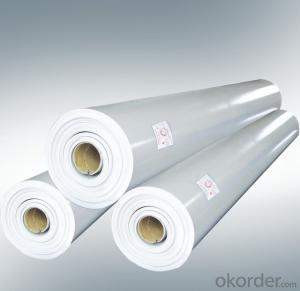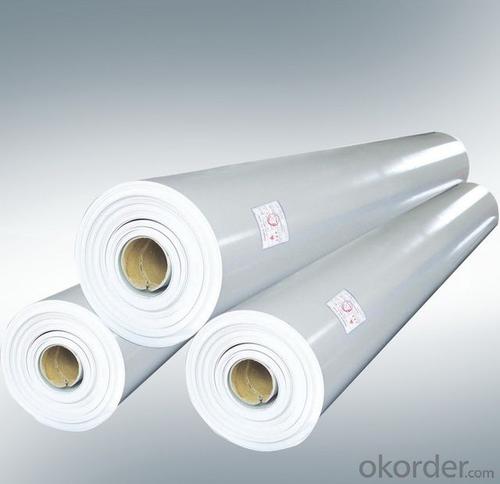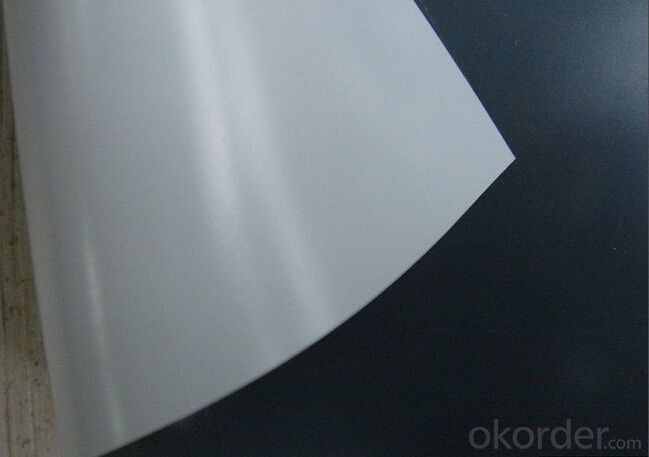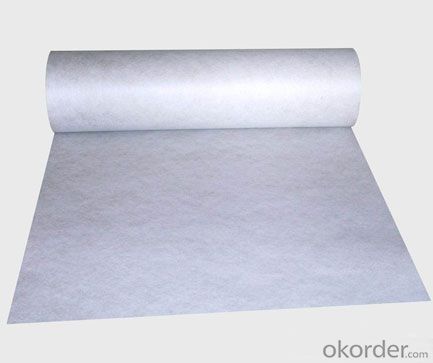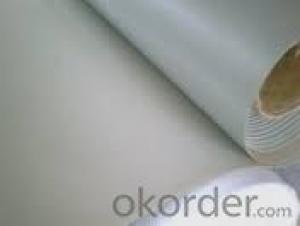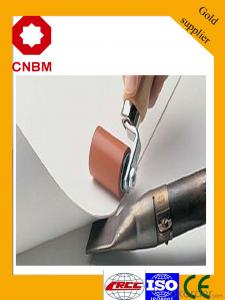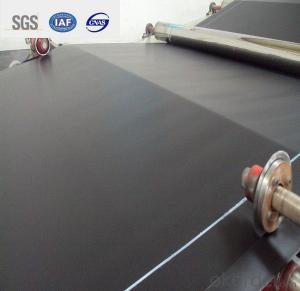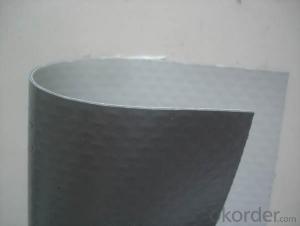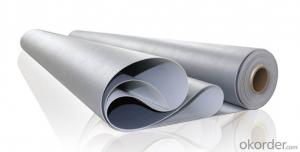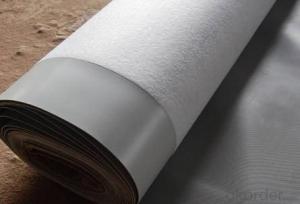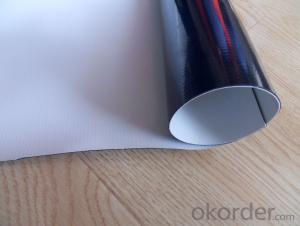PVC Reinforced Waterproofing Membrane without Compound Layer
- Loading Port:
- China main port
- Payment Terms:
- TT OR LC
- Min Order Qty:
- 5000 m²
- Supply Capability:
- 100000 m²/month
OKorder Service Pledge
OKorder Financial Service
You Might Also Like
Introduction
Polyvinyl Chloride (PVC) waterproof membrane is a new polymer waterproof membrane which is made from polyvinyl chloride resin, and mixed with plasticizer, filler, antioxygen, ultraviolet absorber and other auxiliaries.
Specification
No. | Item | L | N | W | ||||
I | II | I | II | I | II | |||
1 | Tensile strength N/cm ≥ | 100 | 160 | 8 | 12 | 100 | 160 | |
2 | fracture elongation %≥ | 150 | 200 | 200 | 200 | 150 | 200 | |
3 | Dimension Changing at heating %≤ | 1.5 | 1 | 3 | 2 | 1.5 | 1 | |
4 | Foldability at low temperature °C | -20 | -25 | -20 | -25 | -20 | -25 | |
5 | Water tightness | No leakage | No leakage | No Leakage | ||||
6 | Joint shear resistance (N/mm)≥ | 3 | 3 | 6 | ||||
7 | Thermal Ageing treatment | Appearance | no bubble | no bubble | no bubble | |||
Tensile strength changing rate % | ±25 | ±20 | ±25 | ±20 | ±25 | ±20 | ||
Breaking elongation changing rate% | ||||||||
8 | Chemical corrosion resistance | foldability at low temperature °C | -15 | -20 | -15 | -20 | -15 | -20 |
Tensile strength changing rate % | ±25 | ±20 | ±25 | ±20 | ±25 | ±20 | ||
Breaking elongation changing rate% | ||||||||
9 | Artificial climate accelerated aging | foldability at low temperature °C | -15 | -20 | -15 | -20 | -15 | -25 |
Tensile strength changing rate % | ±25 | ±20 | ±25 | ±20 | ±25 | ±20 | ||
Breaking elongation changing rate% | ||||||||
Applications
1) All kinds of roofs, such as steel structure roof, planted roof etc.
2) Underground engineering, such as building basement, subways, tunnels, air raid shelter, etc.
3) Other projects like artificial lake, dam, water reservoir, grain storehouse, etc.
Characteristic:
1. Strong tensile strength, high elongation, can fit big deformation of substrates.
2. Excellent anti-extreme weather property, can adapt to various environment temperature difference.
3. Suitable for exposed projects with long lifetime and good anti-aging property.
4. Can be welded firmly and reliably.
5. Outstanding root penetration resistance, best choice for planted roofs.
6. Simple and fast construction without pollution.
7. Great plasticity and fast treatment with corners and details.
RFQ
1. What is your MOQ?
--Our MOQ is 5000 m2
2. Can you provide sample?
--Yes, samples are in stock. we can offer free sample for you.
3. Do you offer OEM service?
--Yes, we can print customers’ logo on the packaging;
And the size and specification can be produced and design according to your demand.
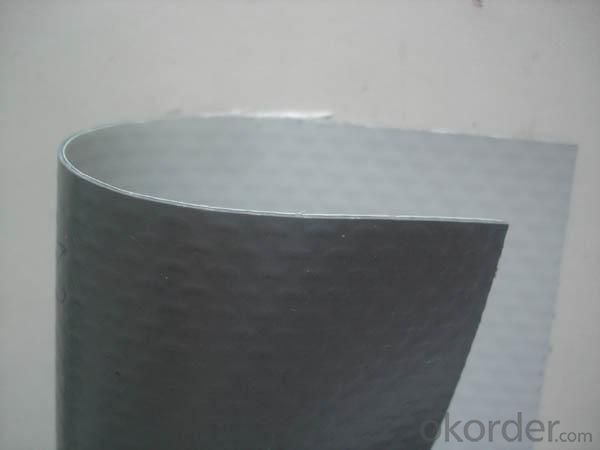
- Q: Can a waterproofing membrane be used for stadiums or arenas?
- Certainly, stadiums and arenas can absolutely benefit from the utilization of waterproofing membranes. In fact, it is highly advisable to employ these membranes in these expansive constructions to shield them from water harm and leaks. These grand structures are frequently subjected to diverse weather conditions, including substantial rainfall and snowfall, which have the potential to infiltrate the edifice with water. A waterproofing membrane functions as a barricade, impeding water from entering the building and causing harm to its structural elements, such as concrete or steel. It aids in upholding the structure's integrity and protracting its lifespan. Moreover, waterproofing membranes also offer protection against other forms of moisture, such as condensation and humidity, which can result in mold growth and materials deterioration. Therefore, the application of a waterproofing membrane is an essential measure in guaranteeing the endurance and longevity of stadiums and arenas.
- Q: Can a waterproofing membrane be used in areas with high foot traffic?
- Areas with high foot traffic can indeed benefit from the use of a waterproofing membrane. These membranes are designed to safeguard against water and moisture, making them suitable for a range of environments, including those that experience heavy foot traffic. In fact, commercial buildings such as shopping malls, hospitals, and office complexes frequently utilize these membranes due to the constant flow of people. However, it is crucial to select the appropriate type of waterproofing membrane specifically designed for high foot traffic areas. Certain membranes possess enhanced durability and resistance to wear and tear, making them an excellent choice for such environments. Furthermore, proper installation and maintenance are essential to ensure the longevity and effectiveness of the membrane in areas with heavy foot traffic. It is also advisable to consider the unique requirements of the area and consult professionals or manufacturers to determine the most suitable waterproofing membrane for the given conditions. By carefully selecting and expertly installing the membrane, one can effectively shield areas with high foot traffic from water damage and ensure their longevity.
- Q: How does a waterproofing membrane handle construction vibrations?
- A waterproofing membrane is designed to handle construction vibrations by providing a durable and flexible barrier that can withstand the movement and impact caused by these vibrations. The membrane is typically made of materials such as rubberized asphalt or synthetic polymers, which have excellent elasticity and tensile strength. When construction vibrations occur, the waterproofing membrane absorbs and dissipates the vibrations, preventing them from affecting the structural integrity of the building or compromising the waterproofing system. The flexibility of the membrane allows it to stretch and contract, accommodating the movement caused by vibrations without cracking or tearing. Additionally, some waterproofing membranes have added features like reinforced layers or fabric reinforcement, which further enhance their ability to withstand construction vibrations. These reinforcements provide additional strength and stability to the membrane, making it more resistant to damage from vibrations. It is important to note that the effectiveness of a waterproofing membrane in handling construction vibrations also depends on the quality of installation. Proper installation techniques, including adequate surface preparation and appropriate adhesion methods, ensure that the membrane is securely attached to the substrate, minimizing the risk of displacement or damage during construction activities. In summary, a waterproofing membrane is specifically designed to handle construction vibrations by absorbing and dissipating the impact, while maintaining its integrity and waterproofing capabilities. The flexibility and strength of the membrane, along with proper installation techniques, ensure that it can withstand the challenges posed by construction vibrations and provide long-lasting protection against water intrusion.
- Q: Can a waterproofing membrane be used in conjunction with expansion joint systems?
- Yes, a waterproofing membrane can be used in conjunction with expansion joint systems. Waterproofing membranes are commonly used to prevent water infiltration and protect structures from moisture damage. Expansion joint systems, on the other hand, are installed to allow for movement and accommodate thermal expansion and contraction in structures. By combining the use of a waterproofing membrane and expansion joint systems, it is possible to provide both waterproofing and movement accommodation in a structure. This ensures that the structure remains protected from water damage while allowing for necessary movement. It is important to properly design and install both the waterproofing membrane and the expansion joint system to ensure their compatibility and effectiveness.
- Q: How do waterproofing membranes prevent water leakage?
- Waterproofing membranes prevent water leakage by creating a physical barrier between the structure and the water. These membranes are made of materials that are impermeable to water, such as rubber, PVC, or bitumen. When applied correctly, they form a continuous and seamless layer that prevents water from seeping through cracks, joints, or other vulnerable areas. This barrier effectively stops water from infiltrating the structure, ensuring its protection against water damage and leakage.
- Q: Can a waterproofing membrane be used on adobe block surfaces?
- Yes, a waterproofing membrane can be used on adobe block surfaces. Waterproofing membranes are commonly used to provide an additional barrier against water penetration and moisture damage, and they can be applied to various surfaces, including adobe blocks, to enhance their water resistance and durability.
- Q: Can a waterproofing membrane be used for zoos or aquariums?
- Yes, a waterproofing membrane can be used for zoos or aquariums. Waterproofing membranes are designed to prevent water penetration and provide a watertight barrier, making them suitable for use in areas that require high levels of water resistance such as zoos or aquariums where water containment is critical.
- Q: Do you know how many square meters of waterproofing membrane to send a set of tests?
- Elastomer Asphalt Waterproofing Sheets: Take a roll out of the outer roll head 2500mm, the vertical cut 800mm full-width coil sample 2. 10000 square meters for a group, the lack of a group also.
- Q: Can a waterproofing membrane be used for below-grade parking structures?
- Yes, a waterproofing membrane can be used for below-grade parking structures. These membranes are designed to provide a barrier against water intrusion and can be applied to the below-grade walls and floors of parking structures to prevent water damage and leakage.
- Q: Can a waterproofing membrane be used on tile surfaces?
- Yes, a waterproofing membrane can be used on tile surfaces. A waterproofing membrane is a thin layer of material that is designed to prevent water or moisture from penetrating through to the underlying surface. It is commonly used in areas where water exposure is high, such as bathrooms, showers, or outdoor areas. When applied properly, a waterproofing membrane can create a barrier that protects the tile surface from water damage, preventing issues such as mold, mildew, or tile deterioration. It is important to ensure that the waterproofing membrane is compatible with the type of tile being used and that it is installed correctly to ensure maximum effectiveness.
Send your message to us
PVC Reinforced Waterproofing Membrane without Compound Layer
- Loading Port:
- China main port
- Payment Terms:
- TT OR LC
- Min Order Qty:
- 5000 m²
- Supply Capability:
- 100000 m²/month
OKorder Service Pledge
OKorder Financial Service
Similar products
Hot products
Hot Searches
Related keywords
